Adding schema markup to your pages can greatly benefit users and search engines alike.
Unfortunately, we’ve seen many brands implement the wrong schema type and then have to undo their work across multiple pages. According to Google's John Mueller, choosing the right schema type all comes down to relevance:
From our guidelines we want to make sure that the structured data you have on your page matches the primary element on your page.”
For enterprise-scale sites with thousands of pages, matching structured data to each page's primary element is no walk in the park. But trust me, it's worth the effort.
Schema optimization provides Google with reliable content information, potentially enabling rich snippets in SERPs.

(Schema give this Google search result unique features, like the image and star rating.)
It also helps search engines understand your content better, increasing your chance of ranking for relevant keywords.
To help you use schema to enhance your SEO strategy, I'll go over the different types of popular schema and effective methods for choosing the right structured data for your page below.
Table of Contents:
Understand the Purpose of Schema Markup
Schema markup helps search engines better understand your content and display it in rich snippets, featured snippets, knowledge panels, and more.
Common benefits include:
- Improved CTR (Click-Through Rate)
- Enhanced search appearance (stars, images, pricing, etc.)
- Increased relevance in voice search and AI-driven queries
The Cost of Implementing the Wrong Schema
Let’s step back for a moment and talk about what happens when brands implement the wrong schema type.
To start, they're being inconsistent with Google. Schema is essentially its own language, so when it's added incorrectly or inappropriately, you’re not speaking the right language or making it easier for the search engine to understand.
Google would rather focus on a website that gives them the correct information. They may not be confident in a search listing with the wrong schema type, and ultimately not show that site on the SERPs!
That means reduced rankings which is the opposite goal of any digital marketing strategy. Not to mention the loss of time it would take to revert the changes.
How Many Types of Schema Are There?
There are currently 797 types of schema and 1,453 schema properties.
All of these are hosted on schema.org — a collaborative, open library of different schemas in numerous different encodings, like RDFa, Microdata and JSON-LD.
Despite there being a few hundred schema types, some are more popular than others.
Popular Schema Types & Their SEO Applications
You may already be familiar with popular schema types such as:
- Article Schema – Optimizes news, blogs, and general articles for rich results and Google News.
- Product Schema – Enhances e-commerce pages with product details like price, availability, and reviews.
- FAQPage Schema – Formats frequently asked questions for rich snippets and voice search optimization.
- Local Business Schema – Improves local SEO by displaying business details in Google search and maps.
- Event Schema – Highlights event details such as date, location, and tickets in search results.
- Review Schema – Enables star ratings and user reviews in search results for credibility and engagement.
- HowTo Schema – Structures step-by-step guides for better visibility in search results.
- Recipe Schema – Enhances recipe pages with cooking times, ingredients, and ratings.
- VideoObject Schema – Optimizes videos for Google Video Search and featured snippets.
- Organization Schema – Provides essential business details, including name, logo, contact info, and social profiles.
… the list goes on!
If one of the above schema types caught your eye, we have some specific resources you can reference:
- Product Schema Markup (Complete Guide For Ecommerce SEO)
- Looking to Capture Search Visibility? Implement the FAQ Schema.
- Schema Markup for Property Listings: Increase Your SERP Visibility
Or, read on to learn about choosing the right schema!
Choosing the Right Schema for Your Content Type
Before we dive into the different steps on how to select the best schema for your specific application, here's a quick list of common content types and their corresponding schema recommendations:
| Content Type | Recommended Schema Markup |
|---|---|
| Blog Post/Article | Article, NewsArticle, BlogPosting |
| Product Page | Product, Offer, AggregateRating, Review |
| Local Business Page | LocalBusiness, Organization |
| Event Page | Event |
| FAQ Section | FAQPage |
| How-To Guide | HowTo |
| Job Listing | JobPosting |
| Recipe Page | Recipe |
| Video Content | VideoObject |
| Software/App | SoftwareApplication, MobileApplication |
| Medical Article | MedicalWebPage, MedicalCondition |
| Review Page | Review, AggregateRating |
If your content fits multiple schemas, use nested schema (e.g., a blog post featuring a recipe can have both BlogPosting and Recipe schema).
How to Pick the Right Schema Type
The few popular schema examples mentioned above don't even scratch the surface of how many options exist.
Navigate schema.org to find which schema type matches the content on your site (or better yet, content about to be built!). But how do you know what you’re looking for? There are a few ways.
Let's start with what Google recommends.
#1. Reference Google’s Structured Data Search Gallery
Google has a great resource that they call the Search Gallery and Rich Results.
Users can choose from eight industry categories and see relevant schema.
Here are your options:
- Ecommerce
- Organizations
- Sports
- Jobs
- Entertainment
- News
- Food and Drink
- Education and Science
If you’re an ecommerce business, for example, Google offers further resources on book, FAQ, product, and review schema. Organizations can choose logo, how-to, home activities, and plenty more.
The search gallery highlights the experiences Google wants to create for its searchers — a good clue to align your site with that experience!
The specifics of these schema type and others can all be found on schema.org.
#2. Look at the Competition
There are several other ways to pick the right schema, so don’t worry if your industry or category isn’t included in Google’s search gallery.
Look at what the competition is doing and consider replicating those efforts.
You can of course look at Google search listings, but remember that not all schema types result in a rich snippet on the SERPs. Consider using the “Inspect” option on a web page and searching for schema types in the search bar.
This will reveal any schema code loaded into the page, as we see here:
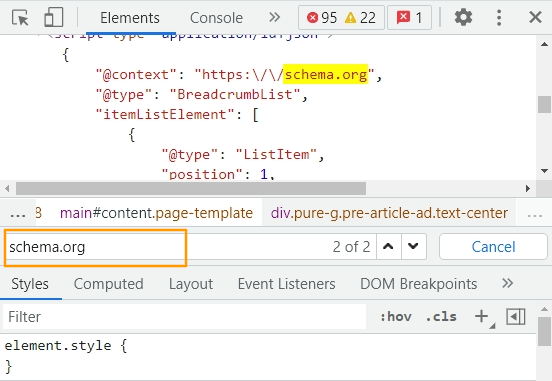 (Inspecting a code for any schema code.)
(Inspecting a code for any schema code.)
Not many people want to inspect multiple pages, especially not for multiple competitors. Fortunately, SEO technology allows you to hunt for schema at scale.
seoClarity users can enter competitor URLs and filter by ranking URL features (i.e. event, price schema, FAQ, stock schema, star rating).
For example, let’s say we want to find all the keywords that trigger the price schema for H&M (our competitor in this hypothetical situation).
A quick filter sets our parameters:
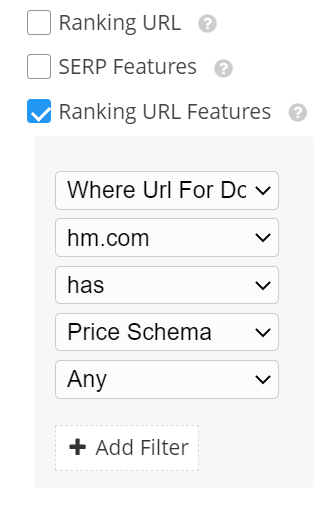 (Filtering by the price schema in seoClarity's Rank Intelligence.)
(Filtering by the price schema in seoClarity's Rank Intelligence.)
And the keyword list is revealed, along with the search volume, rank position, and associated ranked page. This helps to identify opportunities and monitor the competition at scale.
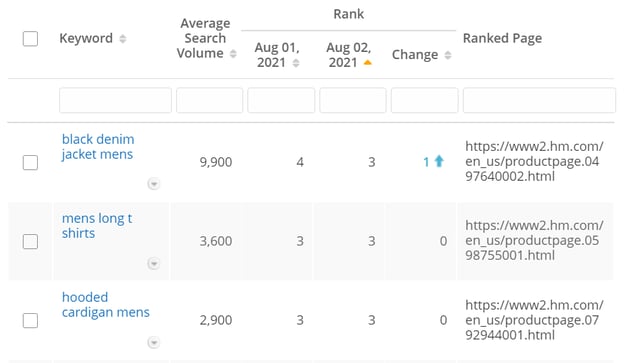
(Queries that trigger the price schema and the respective ranked page.)
A cached version of the SERP confirms that these keywords did trigger the schema type on the results page:
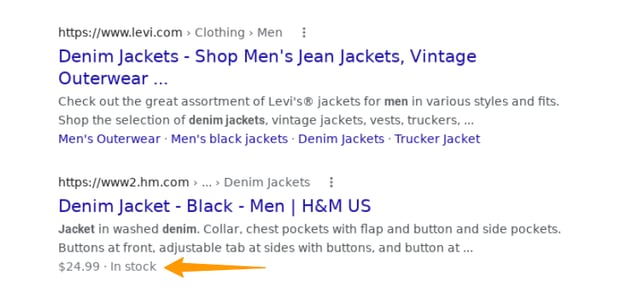
(Confirmation that this schema does appear on the SERP listing.)
#3. Consider the Page’s Relevancy
Each schema type on schema.org has a unique description and intended purpose. Sometimes, it’s best to use your better judgment and ask yourself if a schema type is relevant to the page and its content.
But again, with so many options, how do you make the ultimate decision? Remember what John Mueller said about relevancy and matching the primary element of the page.
To put it simply, if the schema and content don’t align logically then there’s probably a better schema type to implement.
For example, if you have a how-to guide with a small FAQ section at the bottom, you could utilize the FAQ schema as an add-on, but the HowTo schema type is your best option in this case to start. This is also a good reason to avoid using Product schema on category pages.
It all comes down to weighing the relevancy of the schema with the page and gauging whether or not that is going to make sense to Google.
Note: Mueller also points out that the search engine can combine certain schema types in one rich result, like the star rating and image. Remember that recipe example we saw above?

(This recipe schema has a star rating and image.)
Next Steps: Build and Implement Schema
Adding schema to further optimize your pages can cause some worry among SEOs because of the technical components involved (i.e. JSON-LD, Microdata, and RDFa code).
But you’ve made it this far!
Once you’ve determined which schema is right for your page, it’s time to create and implement the code.
#1. Build the Schema Snippet
Now, explaining the nuances of schema code and working it into the backend of your website could be an entire guide on its own (in fact, we put together a whole webinar on the technical best practices of schema).
Luckily, SEOs no longer need to know how to code to write schema code.
Not when there are tools like Schema Builder out there. This free Chrome plug-in operates on a point-and-click interface, so you can build and deploy JSON-LD schema code with a few clicks.
We really mean it! No coding required.
See for yourself: Schema Markup Generator: Build Structured Data Without Developers.
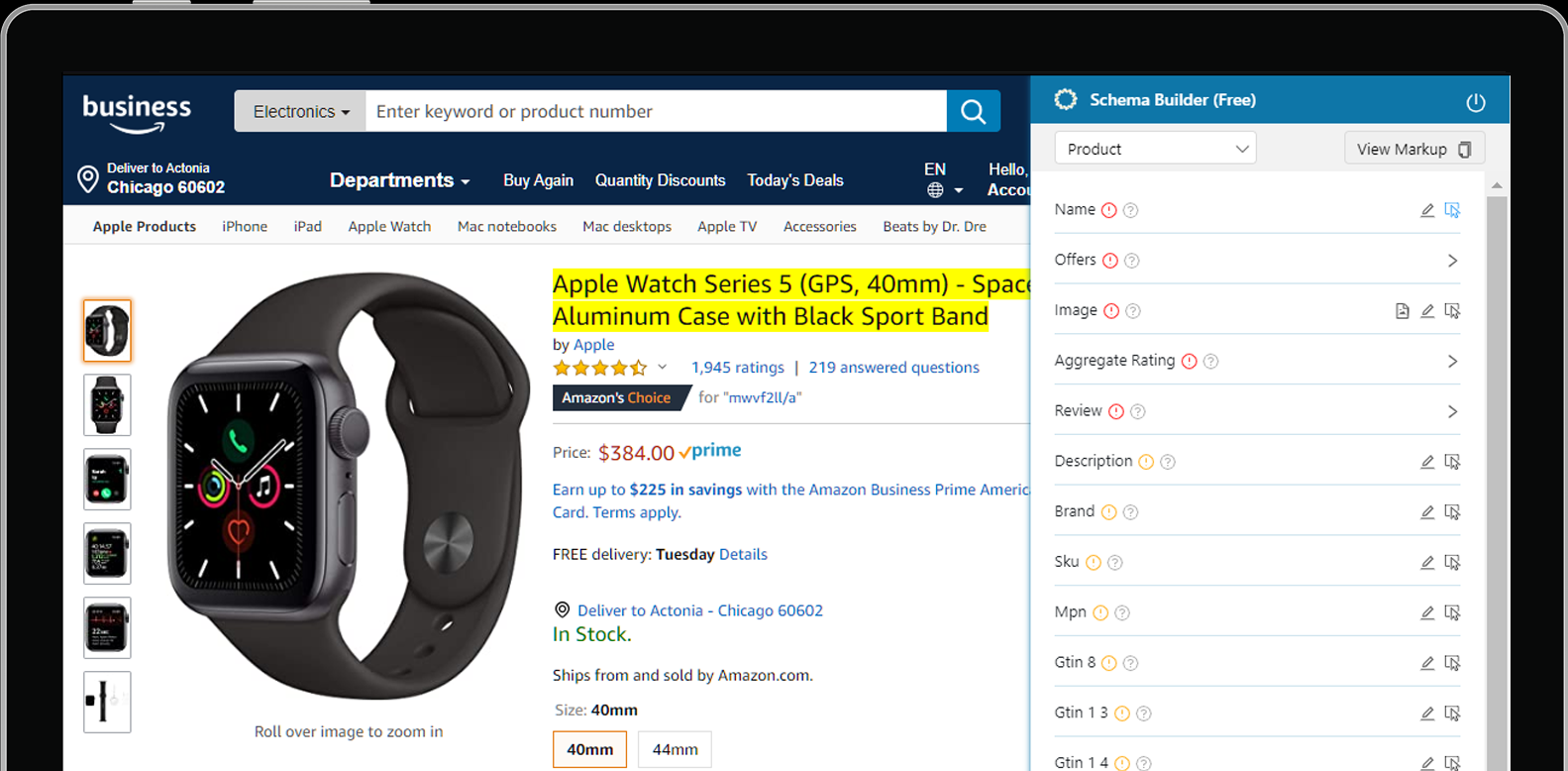 (SEOs can add schema with just a few clicks.)
(SEOs can add schema with just a few clicks.)
#2. Implement the Schema at Scale
A time gap, tech gap, or resource gap usually prevents SEOs from implementing schema on one page, let alone at scale across tens of thousands of pages on an enterprise website.
But that was before Schema Optimizer.
It enables you to build, deploy and manage structured data sitewide, or in sections of a website, like "Products" or "Categories". Implement the code on one page, and watch as it goes to whichever pages fit your specified variables.
This one-to-many implementation method lets you implement schema with a few clicks.
#3. Test the Code
As a final step and precautionary measure, you may choose to audit your schema to confirm that it’s built correctly.
There are a few common issues with schema that can pop up, so a quick audit uncovers any potential roadblocks or hindrances so the schema can work to its full potential.
While Google used to offer its own testing tool, it's since been deprecated by the search engine. But you can still use the Rich Results Test to verify if your page is eligible for rich results (and in turn, verify the code is solid).
To run a test at scale, there are also all-in-one SEO platforms (like seoClarity) that offer advanced crawl and site audit capabilities.
Conclusion
Hopefully, by now, you’re excited about the prospects of what schema can do for your business and already have an idea or two about which types you’d like to implement.
Remember, deciding on the right schema comes down to three things:
- Referencing Google’s schema gallery to see what experiences they’re looking to create for their searchers
- Looking at the competition
- Using your judgement to match the schema to the main element of the page
And don’t forget: SEOs and digital marketers no longer need advanced coding skills to use schema markup on their pages thanks to helpful tools like Schema Builder and Schema Optimizer.
<<Editor's Note: This post was originally published in August 2021 and has since been updated.>>









Comments
Currently, there are no comments. Be the first to post one!